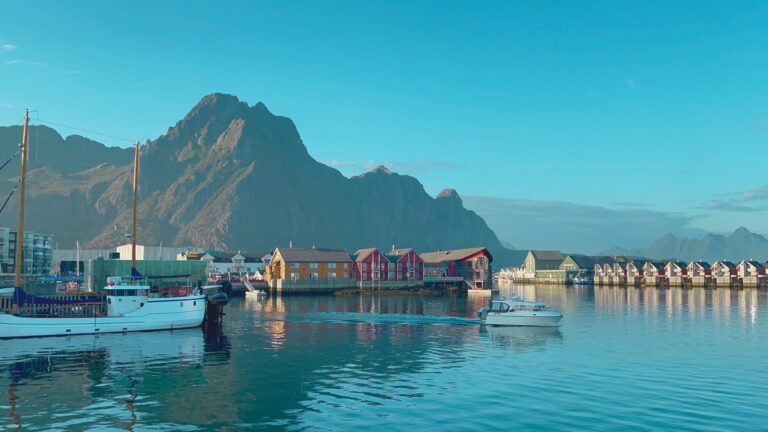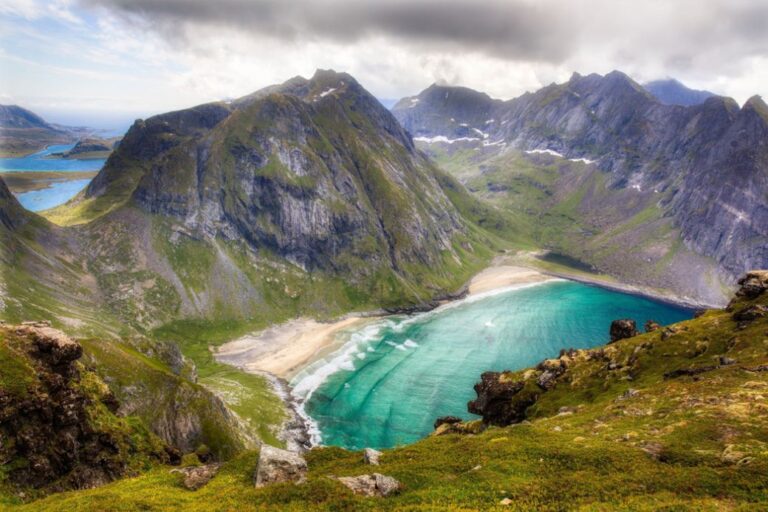Beyond its stunning natural beauty, Lofoten is full of surprises. Learn something new about Norway’s spectacular Lofoten Islands with these ten fascinating facts.
Lofoten is a remote archipelago in Northern Norway, known for its dramatic landscapes, quaint fishing villages, and traditional culture. And views like this:

Despite their remote location, the main Lofoten Islands—Austvågøy, Vestvågøy, flakstadøy, Moskenesøy, Værøy, and Røst—attract visitors from around the world.
But how much do you actually know about this picturesque part of Norway? Read on for some fascinating facts about Lofoten.
1. There are incredible beaches
Lofoten boasts some of the most beautiful beaches in Norway, with white sands and turquoise waters that are more reminiscent of tropical destinations.
Beaches like Haukland, Uttakleiv, and Ramberg are particularly popular, attracting both locals and tourists.
Lofoten Travel Resources: Things To Do In Lofoten – Book Hotels & Cabins – Car Rental – Book Tours & Experiences – Travel Insurance
While some of the islands' beaches are by the roadside, others require a hike. On the plus side, that means they are often quiet, despite their beauty. One of the best examples is Kvalvika on the northern side of Moskenesøy.
Another beach worthy of the effort to reach is the expansive Bunes beach. Located on the northern side of Moskenes, Bunes requires visitors to take a passenger ferry from Reine to the small village of Vindstad, so many people choose to camp.
Despite their beauty, the water temperatures remain quite cold, making Lofoten's beaches more suitable for scenic walks and photography than swimming and sunbathing.
2. It is a hiker’s paradise
Norway isn’t exactly short of fantastic hiking destinations, but Lofoten takes things up a notch. Hiking in Lofoten offers unparalleled views of rugged mountains, deep fjords, picturesque villages, and some of those beaches mentioned earlier.

Popular hikes include Reinebringen, which provides a stunning panoramic view of Reinefjord, and the challenging trek to the summit of Hermannsdalstinden, the highest peak in the region.
Another iconic hike is the ascent of Svolværgeita, or the ‘Svolvær Goat'. This iconic peak is renowned for its distinctive twin pinnacles and offers a thrilling adventure for experienced climbers.
The hike to Svolværgeita combines steep, rugged terrain with breathtaking views over the town of Svolvær and the surrounding archipelago. For the truly daring, reaching the summit offers the chance to jump between the two pinnacles.
There are easier treks too, but just be sure to understand that what a Norwegian terms an “easy” walk, may not be the same as your understanding of the word easy!
3. It’s known for its surfing
Lofoten's beaches aren't just for admiring—they're also a hotspot for surfing. That’s especially so in the village of Unstad, where the impressive swells draw surfers from around the world.
Unstad remained virtually unknown outside of Norway, until media coverage and improved wetsuit technology in the early 2000s put this Arctic beach on the global map for cold-water surfing.
Since 2007, the Lofoten Masters has grown from a local gathering to an international competition. The autumn event is billed as the world's northernmost surfing competition.
Today, Unstad Arctic Surf offers equipment rentals and lessons, making surfing at Unstad possible for both intermediate and experienced surfers.
4. Lofoten isn’t really one place
We say Lofoten all the time, but although it’s a widely used name, it doesn’t actually exist in the world of administration. In terms of Norwegian counties, Lofoten is part of the much bigger Nordland county.

Locally, Lofoten encompasses the municipalities of Vågan, Vestvågøy, Flakstad, Moskenes, Værøy, and Røst. Each of these municipalities carries responsibility for the delivery of local services.
To further complicate matters, Lofoten’s national park, known as Lofotodden National Park, comprises just the south-west section of the mountainous islands. Established in 2018, the area of almost 100 square kilometres now has extra protections in place.
5. Relatively few people live there
You might imagine, given how idyllic the villages of Lofoten are, and how challenging it can be to find accommodation in the summer, that a lot of people scramble to live on the islands.
The truth, however, is quite different. Just 24,500 people call the islands their permanent home.
Aside from the principal cities of Tromsø and Bodø, there is a population decline in Northern Norway. The realities of living in Lofoten can be tough, with isolation, difficult transport, and the lack of job opportunities all challenging.
The biggest urban area, Svolvær, is home to just 4,750 people, highlighting the sparse population spread across the archipelago.
6. The water is very deep
Lofoten is surrounded by some incredibly deep waters. Vestfjorden, which separates Lofoten from the mainland, reaches depths of up to 3,000 meters.
This deep water contributes to the archipelago's rich marine life, supporting abundant fisheries that have been the backbone of the local economy for centuries.
7. Fishing remains important
Fishing has always been a crucial part of life in Lofoten. The region is renowned for its cod fisheries, particularly the seasonal Lofoten cod, or skrei, which migrates from the Barents Sea to spawn near the islands.

This tradition of fishing dates back to the Viking Age and remains a vital industry today, with drying racks of cod, known as stockfish, being a common sight across the islands.
8. Vikings lived in Lofoten
Lofoten has a significant story to tell from the Viking Age. Archaeological discoveries, including the largest known Viking longhouse at Borg on Vestvågøy, provide evidence of human settlement in the Viking Age.
A reconstructed longhouse based on these findings now forms the central attraction at Lofotr Viking Museum. It offers insights into the daily lives and seafaring prowess of the Vikings who once called Lofoten home.
Visitors can explore the impressive structure, which stretches over 83 meters in length, and learn about Viking culture through interactive exhibits and reenactments.
The museum not only showcases the architectural ingenuity of the Vikings but also delves into their agricultural practices, trade networks, and social structures.
Artifacts unearthed in the area, such as tools, jewelry, and pottery, paint a vivid picture of a thriving community deeply connected to both land and sea.
9. Lofoten played a role in World War II
During World War II, Lofoten was strategically important due to both its location and its rich fisheries. The archipelago was the site of several Allied raids, aimed at disrupting German operations and fish oil production, which was crucial for the Nazi war effort.
The most notable of these was Operation Claymore in 1941, where British commandos successfully destroyed fish oil factories and captured German soldiers. This operation inflicted significant damage on the German war economy and provided valuable intelligence for the Allies.
The captured soldiers and documents offered insights into German military plans and operations, contributing to the broader strategic efforts against Nazi Germany.

Subsequent raids continued throughout the war, with Lofoten becoming a persistent thorn in the side of the German occupation forces.
The Norwegian resistance also played a crucial role, providing intelligence and support to the Allied forces. The rugged terrain and remote location of Lofoten made it an ideal base for resistance activities, and many local inhabitants bravely aided the efforts against the occupiers.
Lofoten's role in the war is remembered with pride by the local population, and several memorials and museums in the region commemorate the bravery and sacrifice of those involved.
10. Ferries remain important
Thanks to bridges and tunnels, the main E10 road from west to east through the islands is ferry-free. However, ferries remain an essential mode of transportation in Lofoten.
Lofoten Travel Resources: Things To Do In Lofoten – Book Hotels & Cabins – Car Rental – Book Tours & Experiences – Travel Insurance
They connect smaller islands with the larger islands and the mainland, ensuring the flow of people, goods, and services.
For example, the small island of Skrova, home to just a few hundred people, can only be reached by passenger ferry from Svolvær or the mainland.
The ferries operated by Hurtigruten and Havila, which travel along Norway's coast, also stop in Lofoten at both Stamsund and Svolvær, providing an important link for both locals and tourists.
What's your favourite fun fact about Lofoten? Feel free to share your thoughts and experiences about this wonderful place down in the comments.


